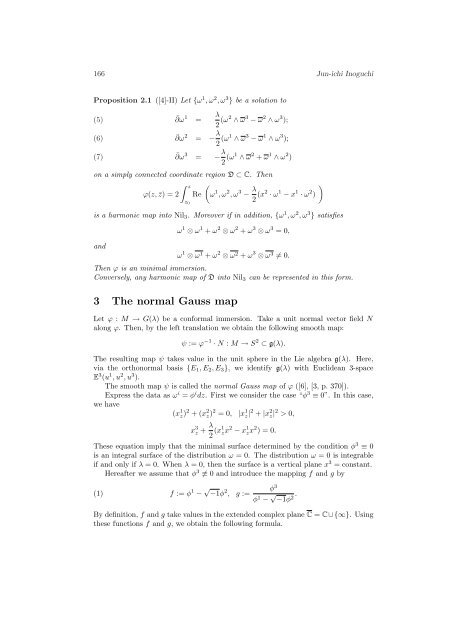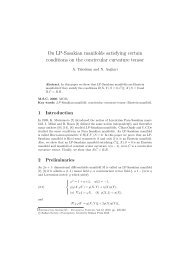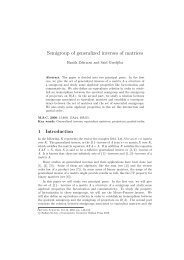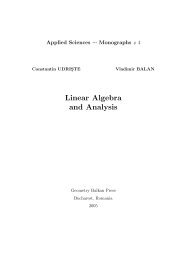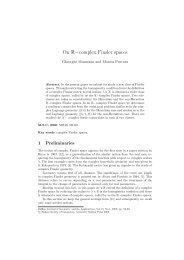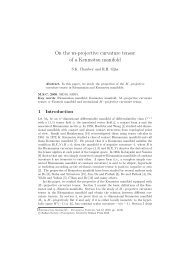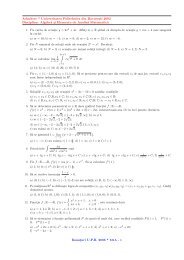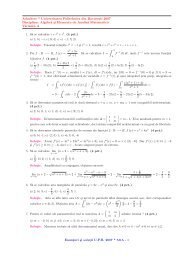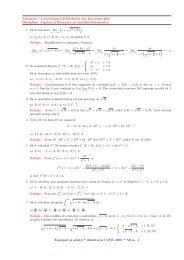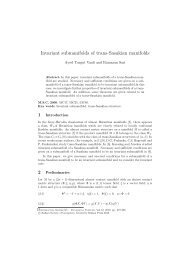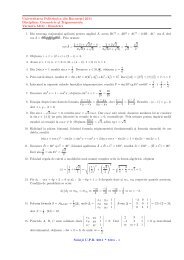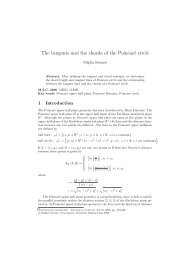Minimal surfaces in the 3-dimensional Heisenberg group
Minimal surfaces in the 3-dimensional Heisenberg group
Minimal surfaces in the 3-dimensional Heisenberg group
Create successful ePaper yourself
Turn your PDF publications into a flip-book with our unique Google optimized e-Paper software.
166 Jun-ichi InoguchiProposition 2.1 ([4]-II) Let {ω 1 , ω 2 , ω 3 } be a solution to(5)(6)(7)¯∂ω 1 =λ2 (ω2 ∧ ω 3 − ω 2 ∧ ω 3 );¯∂ω 2 = − λ 2 (ω1 ∧ ω 3 − ω 1 ∧ ω 3 );¯∂ω 3 = − λ 2 (ω1 ∧ ω 2 + ω 1 ∧ ω 2 )on a simply connected coord<strong>in</strong>ate region D ⊂ C. Then∫ z(ϕ(z, ¯z) = 2 Re ω 1 , ω 2 , ω 3 − λ )z 02 (x2 · ω 1 − x 1 · ω 2 )is a harmonic map <strong>in</strong>to Nil 3 . Moreover if <strong>in</strong> addition, {ω 1 , ω 2 , ω 3 } satisfiesandω 1 ⊗ ω 1 + ω 2 ⊗ ω 2 + ω 3 ⊗ ω 3 = 0,ω 1 ⊗ ω 1 + ω 2 ⊗ ω 2 + ω 3 ⊗ ω 3 ≠ 0.Then ϕ is an m<strong>in</strong>imal immersion.Conversely, any harmonic map of D <strong>in</strong>to Nil 3 can be represented <strong>in</strong> this form.3 The normal Gauss mapLet ϕ : M → G(λ) be a conformal immersion. Take a unit normal vector field Nalong ϕ. Then, by <strong>the</strong> left translation we obta<strong>in</strong> <strong>the</strong> follow<strong>in</strong>g smooth map:ψ := ϕ −1 · N : M → S 2 ⊂ g(λ).The result<strong>in</strong>g map ψ takes value <strong>in</strong> <strong>the</strong> unit sphere <strong>in</strong> <strong>the</strong> Lie algebra g(λ). Here,via <strong>the</strong> orthonormal basis {E 1 , E 2 , E 3 }, we identify g(λ) with Euclidean 3-spaceE 3 (u 1 , u 2 , u 3 ).The smooth map ψ is called <strong>the</strong> normal Gauss map of ϕ ([6], [3, p. 370]).Express <strong>the</strong> data as ω i = φ i dz. First we consider <strong>the</strong> case “φ 3 ≡ 0”. In this case,we have(x 1 z) 2 + (x 2 z) 2 = 0, |x 1 z| 2 + |x 2 z| 2 > 0,x 3 z + λ 2 (x1 zx 2 − x 1 zx 2 ) = 0.These equation imply that <strong>the</strong> m<strong>in</strong>imal surface determ<strong>in</strong>ed by <strong>the</strong> condition φ 3 ≡ 0is an <strong>in</strong>tegral surface of <strong>the</strong> distribution ω = 0. The distribution ω = 0 is <strong>in</strong>tegrableif and only if λ = 0. When λ = 0, <strong>the</strong>n <strong>the</strong> surface is a vertical plane x 3 = constant.Hereafter we assume that φ 3 ≢ 0 and <strong>in</strong>troduce <strong>the</strong> mapp<strong>in</strong>g f and g by(1) f := φ 1 − √ −1φ 2 , g :=φ 3φ 1 − √ −1φ 2 .By def<strong>in</strong>ition, f and g take values <strong>in</strong> <strong>the</strong> extended complex plane C = C∪{∞}. Us<strong>in</strong>g<strong>the</strong>se functions f and g, we obta<strong>in</strong> <strong>the</strong> follow<strong>in</strong>g formula.


